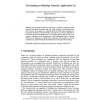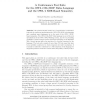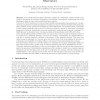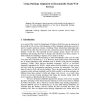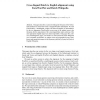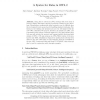SEMWEB
2009
Springer
14 years 6 months ago
2009
Springer
Abstract. Semantic applications that utilise OWL ontologies can benefit from a broad range of OWL reasoning systems, which allow for the inference of implicit knowledge from expli...
SEMWEB
2009
Springer
14 years 6 months ago
2009
Springer
The biomedical ontology community is producing ontologies which represent biological knowledge and with a bias towards a realist pe...
SEMWEB
2009
Springer
14 years 6 months ago
2009
Springer
We present the first version of a comprehensive conformance test suite for reasoners implementing the OWL 2 RL/RDF rules language and compliant super languages, up to the scale of...
SEMWEB
2009
Springer
14 years 6 months ago
2009
Springer
The Virtual Solar-Terrestrial Observatory (VSTO) is a distributed, scalable education and research environment for searching, integrating, and analyzing observational, experimental...
SEMWEB
2009
Springer
14 years 6 months ago
2009
Springer
In many data-centric applications, it is desirable to use OWL as an expressive schema language with which one expresses constraints that must be satisfied by instance data. Howeve...
SEMWEB
2009
Springer
14 years 6 months ago
2009
Springer
With OWL 2 about to be completed, it is the right time to start discussions on possible future modifications of OWL. We present here a number of suggestions in order to discuss th...
SEMWEB
2009
Springer
14 years 6 months ago
2009
Springer
This statement of interest presents a brief rationale and description of issues for using ontology alignment as a key step in dynamically chaining together a sequence of web servic...
SEMWEB
2009
Springer
14 years 6 months ago
2009
Springer
Abstract. This paper describes a system for linking the thesaurus of the Netherlands Institute for Sound and Vision to English WordNet and dbpedia. We used EuroWordNet, a multiling...
SEMWEB
2009
Springer
14 years 6 months ago
2009
Springer
Ontologies are entities that evolve over time, therefore it is essential to represent and manage changes to ontologies along with the ontologies themselves. In this paper we propos...
SEMWEB
2009
Springer
14 years 6 months ago
2009
Springer
Being able to extend an OWL ontology with some form of rules is a feature that many ontology developers consider as very important. Nevertheless, working with rules in practice can...

